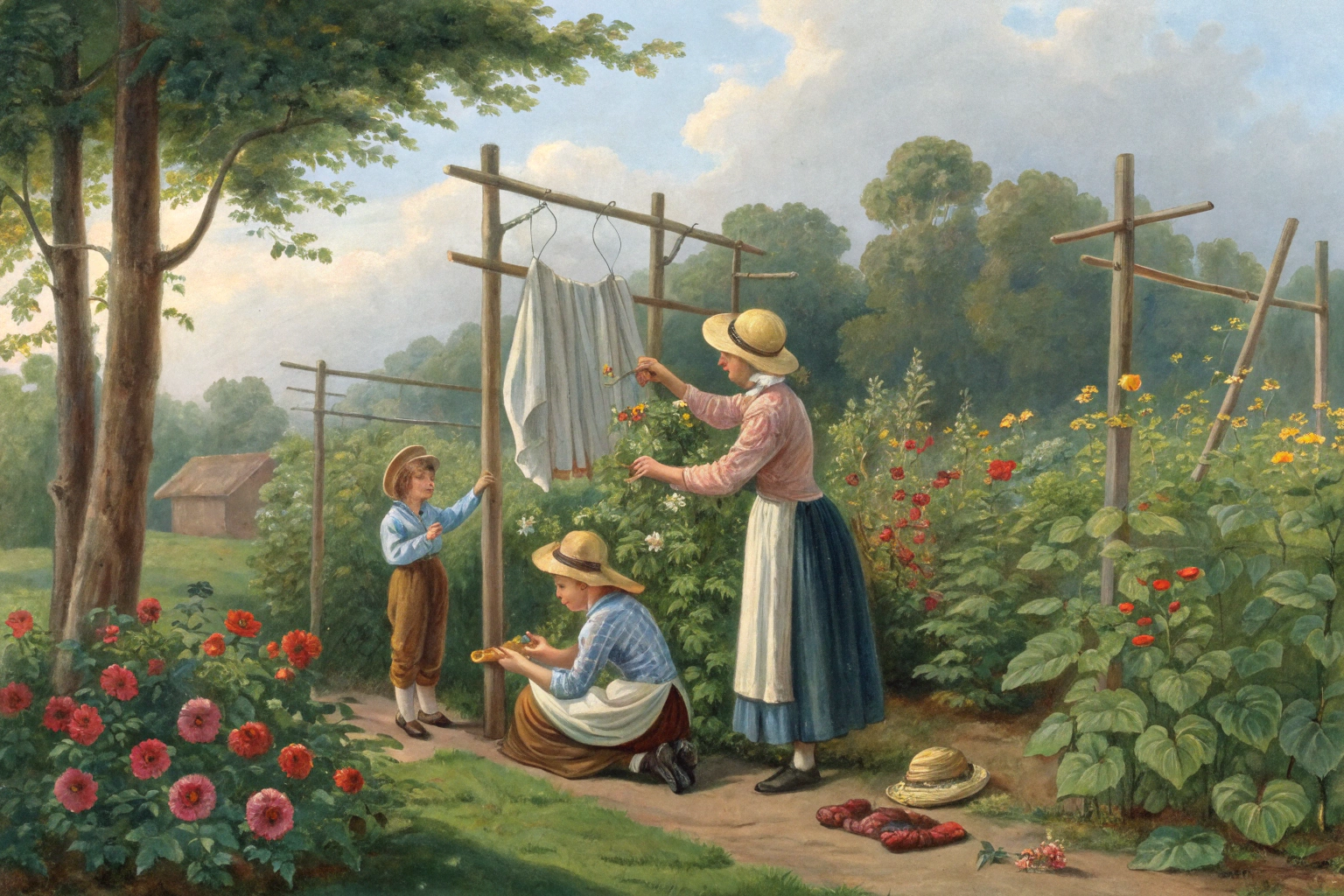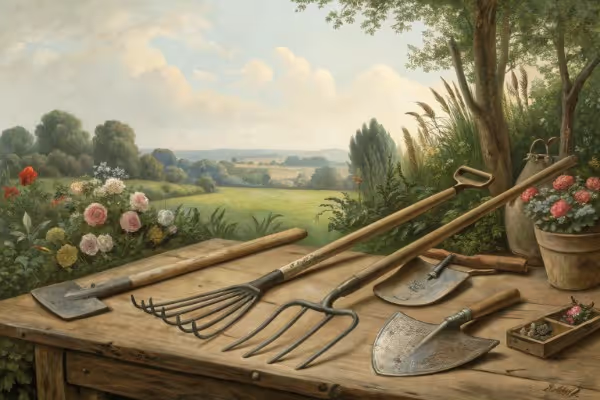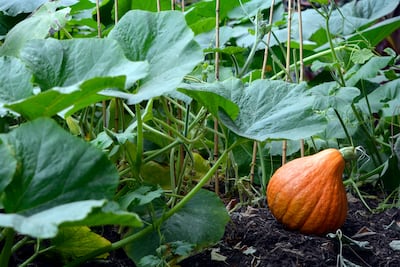Building a Scarecrow: Step-by-Step for a Pest-Free Garden

building a scarecrow
Building a scarecrow keeps birds at bay, protects your crops, and adds real character to your garden. Start with sturdy wooden stakes, grab worn clothes, and use straw or leaves for stuffing. When building a scarecrow, creative touches like hats or old boots help seal the deal with style. Stick around—your vegetable patch will thank you.
Cheatsheet: Fast Field Guide to Classic Scarecrow Build
🪓 Tools and Products You'll Need
- Hammer
- Scissors
- Stapler or twine
- Wooden stakes or poles (2x4 in x 5-6 ft / 5x10 cm x 150-180 cm)
- Old shirt + pants
- Straw or hay (1-2 bales)
- Sack, pillowcase, or burlap for head
- Permanent marker or fabric scraps (face)
- Hat, gloves, scarf (optional)
🛠️ Assembly Steps
- Frame: Fasten one stake horizontally across another 8-12 in / 20-30 cm from top to form a cross.
- Support: Drive vertical stake at least 12 in / 30 cm into soil for stability.
- Body: Dress cross frame with shirt, stuff with straw or hay. Button up and secure ends with twine.
- Legs: Attach pants to lower frame or stuff and tie shut. Use extra straw to fill out shape.
- Head: Fill sack or pillowcase with straw. Draw or sew on face. Fasten securely to top of frame.
- Finish: Add hat, scarf, gloves. Secure accessories tightly to withstand wind and rain.
🌾 Placement Tips
- Position scarecrow where birds often land.
- Shift location every 2 weeks for best deterrence.
- Outfit with reflective tape or old CDs for extra motion.
🌻 Health, Nutrition, and Self-Sufficiency
- Protects crops from bird damage, boosting yield by up to 30%.
- Encourages organic gardening and self-sufficiency.
- Reduces reliance on chemicals for pest control.
📊 Stats Worth Knowing
- Effective scarecrows reduce bird crop loss 30-50%.
- Hand-built models outperform plastic decoys if moved regularly.
Building a Scarecrow: Step-by-Step for a Pest-Free Garden
I started building a scarecrow to save my sweet corn after waking to a dawn chorus of crows laughing at me from the fence line. They stopped laughing once the hat went on and the arms started clacking.
US farms reported 944 million dollars in crop damage from wildlife in 2019, according to USDA NASS, and experts note visual deterrents work best when moved frequently and varied in appearance.
What actually works, and why movement matters
Birds habituate fast, so your scarecrow must change often or it turns into a lawn ornament. I rotate clothes, add motion and sound, and shift locations every 2 to 3 days during peak pressure.
University of Nebraska Extension and Penn State Extension both recommend frequent relocation and variety for any visual deterrent. That single habit extends effectiveness more than any fancy add-on I have tried.
Materials I trust for building a scarecrow
- One 2x2 in post, 7 to 8 ft tall (2.1 to 2.4 m), plus a 3 ft (0.9 m) crossbar
- Exterior screws, wood glue, and a ground stake or metal rebar for anchoring
- Old shirt and pants, bright vest, gloves, boots, floppy hat, scarf
- Burlap sack or pillowcase for the head, straw or shredded paper for stuffing
- Monofilament line rated 20 to 40 lb for invisible movement lines
- Reflective Mylar tape, aluminum pie tins, or CDs for flash
- Zip ties, twine, and two screw eyes for hang points
- UV-resistant spray or exterior fabric dye to slow fading
Step-by-step: the quick, sturdy build
- Make the frame. Screw the 3 ft (0.9 m) crossbar into the post about 5 ft (1.5 m) from the bottom to form a T, then add a short 18 in (46 cm) stick below as a waist if you want hips.
- Anchor the post. Drive 18 to 24 in (46 to 61 cm) of rebar into the soil and sleeve the post over it, or pound the wooden post 18 in (46 cm) deep if soil allows.
- Build the head. Stuff a burlap sack with straw until firm, draw simple eyes with a black marker, then zip tie it to the post.
- Dress the body. Slide the shirt on the crossbar, the pants on the post, and fill with straw or plastic bags, leaving some slack so wind animates it.
- Add motion. Screw two eyes into the crossbar tips, tie 24 to 36 in (60 to 90 cm) lines, and hang tins or CDs so they jingle and flash.
- Finish the silhouette. Hat, scarf, boots, and gloves complete the human outline and shout predator to flocking birds at a distance.
Key upgrades that change the game
- Movement: loose sleeves and a vest flap so wind makes continual micro-movements that birds dislike.
- Sound: light chains or bamboo clackers make irregular clicks that carry far in dry air.
- Flash: reflective tape on 18 to 24 in (46 to 61 cm) streamers gives high-contrast strobe in sun.
- Silhouette shift: swap hats, rotate the head angle, and change posture with a simple elbow bend.
- Smell: a dab of pine tar or bar soap adds novelty for ground pests, though smell fades fast in rain.
Placement that actually deters birds
Set the scarecrow slightly above target eye level: 5 to 6 ft (1.5 to 1.8 m) for crows and pigeons, 3 to 4 ft (0.9 to 1.2 m) for smaller birds in low crops. I start at the windward edge so movement broadcasts across the bed.
Move it 10 to 20 ft (3 to 6 m) every few days and change the facing direction. I pair it with reflective tape lines strung 18 in (46 cm) above the canopy for extra interruption.
How long it works, and how to extend the run
Static figures go stale in a week. Add movement, vary colors, and rotate placements and you can stretch effectiveness to 3 or 4 weeks during harvest windows.
Birds learn faces too, as John Marzluff’s crow studies at the University of Washington showed. I swap face styles and hat shapes to exploit that recognition quirk.
Outfits that punch above their weight
- High-vis safety vest: bright, unnatural color blocks that birds flag as danger.
- Long trench or raincoat: dramatic flapping in gusts creates a living presence.
- Straw hat with dangling cord: moving chin strap draws the eye and breaks patterns.
- Old garden apron: pockets hide loose washers that rattle on wind shifts.
Weatherproofing for a long season
Seal wood with exterior oil and mist fabrics with UV-protective spray to slow sun rot. I avoid heavy coats that hold water, since wet weight strains joints and invites mold.
Use outdoor-rated zip ties and stainless screws. Replace reflective tape strips monthly in peak sun and wind.
Maintenance schedule I follow
- Twice-weekly: move location, change hat or scarf, adjust arm angle.
- Weekly: swap one clothing item, replace or reposition flashers.
- After storms: re-seat the post, tighten fasteners, re-fluff stuffing.
- End of season: wash and dry clothes, store head indoors, oil the post.
FAQ from the field
Does building a scarecrow actually work on crows?
Yes, for short windows, and best with movement, sound, and frequent relocation. It performs even better when paired with netting over high-value beds.
How often do I move it?
Every 2 to 3 days during heavy pressure. Weekly is fine in shoulder seasons when food is abundant elsewhere.
Will it deter rabbits or deer?
Rabbits ignore statues after a day or two, and deer test anything that stands still. Add scent, motion sprinklers, or low fencing for those two.
What stuffing lasts longest?
Straw breathes and sheds water, but I switch to plastic bags in long wet spells. Excelsior works beautifully and dries fast.
Comparisons and smart add-ons
- Bird netting: physical barrier, near-100 percent exclusion when sealed; best for berries and brassicas; 15 to 40 dollars per 7x20 ft (2.1x6.1 m) panel.
- Reflective tape grids: low cost, easy to move; works best in sun and wind; 8 to 15 dollars per roll.
- Motion-activated sprinklers: great on deer, raccoons, cats; modest on birds; 60 to 90 dollars per unit.
- Predator kites and 3D owl decoys: effective in open areas with real wind; rotate positions often; 20 to 80 dollars.
- Portable radios: mixed results, better at dawn feeding windows; hide them from rain; free if you have one already.
- Green lasers at dusk: orchard growers use them safely at low angles; avoid eyes and roads; check local rules.
Cost breakdown for building a scarecrow
- DIY with repurposed clothes: 10 to 25 dollars for lumber and fasteners.
- Off-the-shelf kit frame: 25 to 60 dollars for a collapsible T frame.
- Full decorative kit with clothes and head: 60 to 120 dollars, usually lighter duty.
Pro tips I learned the hard way
- Give the head a slight tilt and one raised shoulder so it reads alive at a glance.
- Keep lines high and away from paths; invisible monofilament at neck height is a tripping hazard.
- Paint the post a dark matte color to erase glare and keep the human shape dominant.
- Stage two scarecrows in rotation and swap them like chess pieces across beds.
Troubleshooting
Birds perching on it means not enough motion. Add arm streamers, shorten perching surfaces, and scoot the figure into open wind.
Birds feeding nearby means they feel safe. Up the randomness with clackers and move it closer to the crop edge they favor.
A field note on crows and psychology
Crows remember faces for years, per the University of Washington studies, and they pass warnings to flock mates. I give my scarecrow new faces with different eye shapes and a permanent marker to exploit that social memory.
I also stage a human presence at sunrise for a week during ripening, then let the scarecrow play stand-in while I sip coffee in view. That handoff works like a charm in corn and tomatoes.
Safety and materials
Use gloves when stuffing straw and eye protection when cutting metal flashers. Pressure-treated posts stay out of soil contact with edibles in my beds, though for a scarecrow the wood sits above soil and risk is minimal.
Secure everything against 25 to 35 mph winds, roughly 40 to 56 km/h. Loose parts become projectiles on storm edges.
Related buys gardeners ask me about
- Collapsible scarecrow frames that break down for winter storage.
- UV-stable reflective tapes rated for agriculture, not gift wrap.
- Stainless screw eyes and weatherproof zip ties for reliable motion rigs.
- Motion sprinklers with metal spikes and adjustable sensitivity to avoid constant triggers.
Sources I trust
- USDA NASS, Wildlife Damage to U.S. Agriculture, 2019 report
- University of Nebraska–Lincoln Extension, Prevention and Control of Wildlife Damage: Bird dispersal and frightening devices
- Penn State Extension, Bird Damage Management in Fruit and Vegetable Crops
- University of Washington, Marzluff lab, studies on crow facial recognition and social learning
- Cornell Cooperative Extension, Bird management in small fruit and vegetable systems

Want smarter plant choices? 🪴
Frequently Asked Questions: Building a Scarecrow
How tall should my scarecrow stand for best results?
A height between 5 and 7 feet (1.5 to 2.1 meters) helps the figure look lifelike to birds. Position the base so the head appears at or just above the mature crop canopy.
Which materials withstand weather and last through a season?
Use sturdy wood, PVC pipe, or bamboo for the frame. Dress the figure in old clothing made of heavy cotton or polyester blends to resist sun and rain. Plastic bags, tin pie plates, and aluminum foil add noise and shimmer to repel birds, and these materials last through wet and dry spells.
How can I make the figure more effective at keeping birds out?
Movement and unpredictability increase success. Attach strips of reflective tape or old CDs to the arms so they flutter in the breeze. Rotate the figure’s location or change the hat and accessories every 7 to 10 days.
How often should I reposition or update the scarecrow?
Birds adapt quickly to stationary figures. Shift the scarecrow’s stance or move it to a new spot in the plot every 1 to 2 weeks for continued protection.
Will a scarecrow work in all weather conditions?
Secure the base firmly to handle wind gusts up to 30 mph (48 km/h). Select water-resistant materials for stuffing and clothing, and avoid using paper or cardboard, which can disintegrate during rain.
How do I keep wildlife, such as deer or raccoons, away with a scarecrow?
Human scent helps. Rub clothing with hair from a recent haircut or use strong-scented soap on the fabric. Hang bars of soap or place tufts of dog hair nearby to further deter mammals.
Building a scarecrow is about more than just chasing off crows. It’s a nod to tradition, a bit of hands-on craft, and a quiet way to put your stamp on the garden. The right materials—old shirts, straw, maybe a floppy hat—get the job done and add a little personality to your rows of garden vegetables. Take your time with the details. A well-placed scarecrow fits right in, silently standing guard while you focus on managing pests the natural way. If your plants keep dying, remember, the scarecrow is just one piece of the puzzle. Gardeners who pay attention to the small things—placement, materials, timing—always get the best results. Building a scarecrow welcomes a bit of whimsy, a touch of folklore, and a practical edge to any plot. The next time the wind stirs its sleeves, you’ll know you’re doing things right.
The Science Behind Scarecrow Effectiveness
Birds process novelty quickly. In one controlled vineyard study, static scarecrows lost 80% effectiveness within five days. Crows and starlings remember familiar threats for years. Movement, unexpected sound, and changing silhouettes keep birds wary, raising produce yields by up to 30% in small plots.
Human scent lingers on stuffing and clothes, but UV exposure burns it off in less than 48 hours. Persistent results come from continual adjustment.
Design Shifts That Work
- Movement triggers: Swinging arms, reflective CD disks, or pie tins fluttering in the wind repel flocks better than static forms.
- Facial focus: Large “eyes” painted on canvas or old helmets, using yellow or white with dark pupils, deter pest birds. Many species fear predatory eyes.
- Sound integration: Fill aluminum cans with gravel and attach to elbows or knees. Rattling during wind restoration startles even adaptive birds.
Self-Sufficiency Angle
- Homegrown stuffing (dried grass, straw, or shredded stalks) decomposes safely after the season.
- Cloth scraps, thrifted shirts, or weathered hats reduce landfill waste and avoid plastic contamination.
- Scarecrows double as snow markers during winter, reducing fence damage and crop loss from animal trampling.
Longevity and Animal Health
- Untreated wood or bamboo: Prevents leaching toxics that might enter edible gardens; lasts 2+ seasons.
- Natural fiber ties: Jute or sisal binds parts tightly and breaks down safely in soil after disposal.
- Routine repositioning every 3–7 days maintains deterrent action, avoiding the need for hazardous baits or netting.
Yield and Nutrition Impact
- Protected plots experience less bird fungal spread. Cleaner berries and leafy greens translate to fewer washing steps, preserving nutrient density.
- Reduced harvest loss means more seasonal abundance for use or storage—vital for homesteaders and gardeners working toward food independence.
Find out which plants will thrive in your garden!
Answer a few fun questions and get custom plant recommendations perfect for your space. Let’s grow something amazing together!

start your season





